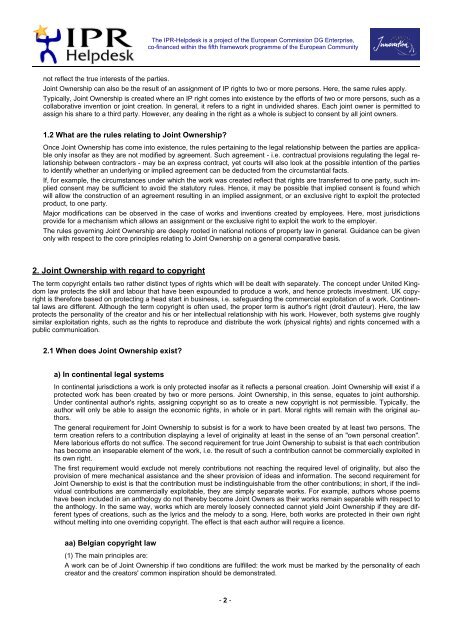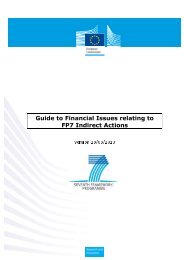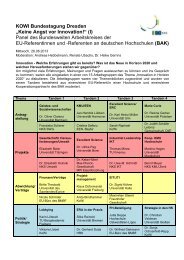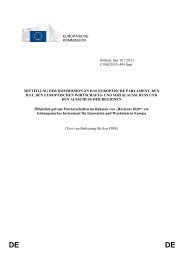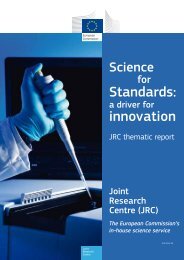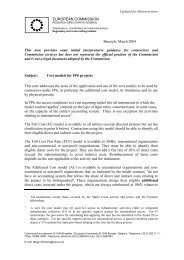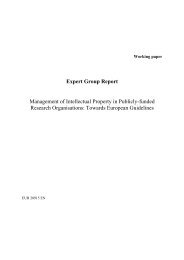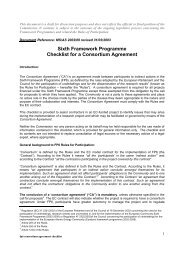Joint Ownership in Intellectual Property Rights - KoWi
Joint Ownership in Intellectual Property Rights - KoWi
Joint Ownership in Intellectual Property Rights - KoWi
You also want an ePaper? Increase the reach of your titles
YUMPU automatically turns print PDFs into web optimized ePapers that Google loves.
The IPR-Helpdesk is a project of the European Commission DG Enterprise,<br />
co-f<strong>in</strong>anced with<strong>in</strong> the fifth framework programme of the European Community<br />
not reflect the true <strong>in</strong>terests of the parties.<br />
<strong>Jo<strong>in</strong>t</strong> <strong>Ownership</strong> can also be the result of an assignment of IP rights to two or more persons. Here, the same rules apply.<br />
Typically, <strong>Jo<strong>in</strong>t</strong> <strong>Ownership</strong> is created where an IP right comes <strong>in</strong>to existence by the efforts of two or more persons, such as a<br />
collaborative <strong>in</strong>vention or jo<strong>in</strong>t creation. In general, it refers to a right <strong>in</strong> undivided shares. Each jo<strong>in</strong>t owner is permitted to<br />
assign his share to a third party. However, any deal<strong>in</strong>g <strong>in</strong> the right as a whole is subject to consent by all jo<strong>in</strong>t owners.<br />
1.2 What are the rules relat<strong>in</strong>g to <strong>Jo<strong>in</strong>t</strong> <strong>Ownership</strong>?<br />
Once <strong>Jo<strong>in</strong>t</strong> <strong>Ownership</strong> has come <strong>in</strong>to existence, the rules perta<strong>in</strong><strong>in</strong>g to the legal relationship between the parties are applicable<br />
only <strong>in</strong>sofar as they are not modified by agreement. Such agreement - i.e. contractual provisions regulat<strong>in</strong>g the legal relationship<br />
between contractors - may be an express contract, yet courts will also look at the possible <strong>in</strong>tention of the parties<br />
to identify whether an underly<strong>in</strong>g or implied agreement can be deducted from the circumstantial facts.<br />
If, for example, the circumstances under which the work was created reflect that rights are transferred to one party, such implied<br />
consent may be sufficient to avoid the statutory rules. Hence, it may be possible that implied consent is found which<br />
will allow the construction of an agreement result<strong>in</strong>g <strong>in</strong> an implied assignment, or an exclusive right to exploit the protected<br />
product, to one party.<br />
Major modifications can be observed <strong>in</strong> the case of works and <strong>in</strong>ventions created by employees. Here, most jurisdictions<br />
provide for a mechanism which allows an assignment or the exclusive right to exploit the work to the employer.<br />
The rules govern<strong>in</strong>g <strong>Jo<strong>in</strong>t</strong> <strong>Ownership</strong> are deeply rooted <strong>in</strong> national notions of property law <strong>in</strong> general. Guidance can be given<br />
only with respect to the core pr<strong>in</strong>ciples relat<strong>in</strong>g to <strong>Jo<strong>in</strong>t</strong> <strong>Ownership</strong> on a general comparative basis.<br />
2. <strong>Jo<strong>in</strong>t</strong> <strong>Ownership</strong> with regard to copyright<br />
The term copyright entails two rather dist<strong>in</strong>ct types of rights which will be dealt with separately. The concept under United K<strong>in</strong>gdom<br />
law protects the skill and labour that have been expounded to produce a work, and hence protects <strong>in</strong>vestment. UK copyright<br />
is therefore based on protect<strong>in</strong>g a head start <strong>in</strong> bus<strong>in</strong>ess, i.e. safeguard<strong>in</strong>g the commercial exploitation of a work. Cont<strong>in</strong>ental<br />
laws are different. Although the term copyright is often used, the proper term is author's right (droit d'auteur). Here, the law<br />
protects the personality of the creator and his or her <strong>in</strong>tellectual relationship with his work. However, both systems give roughly<br />
similar exploitation rights, such as the rights to reproduce and distribute the work (physical rights) and rights concerned with a<br />
public communication.<br />
2.1 When does <strong>Jo<strong>in</strong>t</strong> <strong>Ownership</strong> exist?<br />
a) In cont<strong>in</strong>ental legal systems<br />
In cont<strong>in</strong>ental jurisdictions a work is only protected <strong>in</strong>sofar as it reflects a personal creation. <strong>Jo<strong>in</strong>t</strong> <strong>Ownership</strong> will exist if a<br />
protected work has been created by two or more persons. <strong>Jo<strong>in</strong>t</strong> <strong>Ownership</strong>, <strong>in</strong> this sense, equates to jo<strong>in</strong>t authorship.<br />
Under cont<strong>in</strong>ental author's rights, assign<strong>in</strong>g copyright so as to create a new copyright is not permissible. Typically, the<br />
author will only be able to assign the economic rights, <strong>in</strong> whole or <strong>in</strong> part. Moral rights will rema<strong>in</strong> with the orig<strong>in</strong>al authors.<br />
The general requirement for <strong>Jo<strong>in</strong>t</strong> <strong>Ownership</strong> to subsist is for a work to have been created by at least two persons. The<br />
term creation refers to a contribution display<strong>in</strong>g a level of orig<strong>in</strong>ality at least <strong>in</strong> the sense of an "own personal creation".<br />
Mere laborious efforts do not suffice. The second requirement for true <strong>Jo<strong>in</strong>t</strong> <strong>Ownership</strong> to subsist is that each contribution<br />
has become an <strong>in</strong>separable element of the work, i.e. the result of such a contribution cannot be commercially exploited <strong>in</strong><br />
its own right.<br />
The first requirement would exclude not merely contributions not reach<strong>in</strong>g the required level of orig<strong>in</strong>ality, but also the<br />
provision of mere mechanical assistance and the sheer provision of ideas and <strong>in</strong>formation. The second requirement for<br />
<strong>Jo<strong>in</strong>t</strong> <strong>Ownership</strong> to exist is that the contribution must be <strong>in</strong>dist<strong>in</strong>guishable from the other contributions; <strong>in</strong> short, if the <strong>in</strong>dividual<br />
contributions are commercially exploitable, they are simply separate works. For example, authors whose poems<br />
have been <strong>in</strong>cluded <strong>in</strong> an anthology do not thereby become <strong>Jo<strong>in</strong>t</strong> Owners as their works rema<strong>in</strong> separable with respect to<br />
the anthology. In the same way, works which are merely loosely connected cannot yield <strong>Jo<strong>in</strong>t</strong> <strong>Ownership</strong> if they are different<br />
types of creations, such as the lyrics and the melody to a song. Here, both works are protected <strong>in</strong> their own right<br />
without melt<strong>in</strong>g <strong>in</strong>to one overrid<strong>in</strong>g copyright. The effect is that each author will require a licence.<br />
aa) Belgian copyright law<br />
(1) The ma<strong>in</strong> pr<strong>in</strong>ciples are:<br />
A work can be of <strong>Jo<strong>in</strong>t</strong> <strong>Ownership</strong> if two conditions are fulfilled: the work must be marked by the personality of each<br />
creator and the creators' common <strong>in</strong>spiration should be demonstrated.<br />
- 2 -


